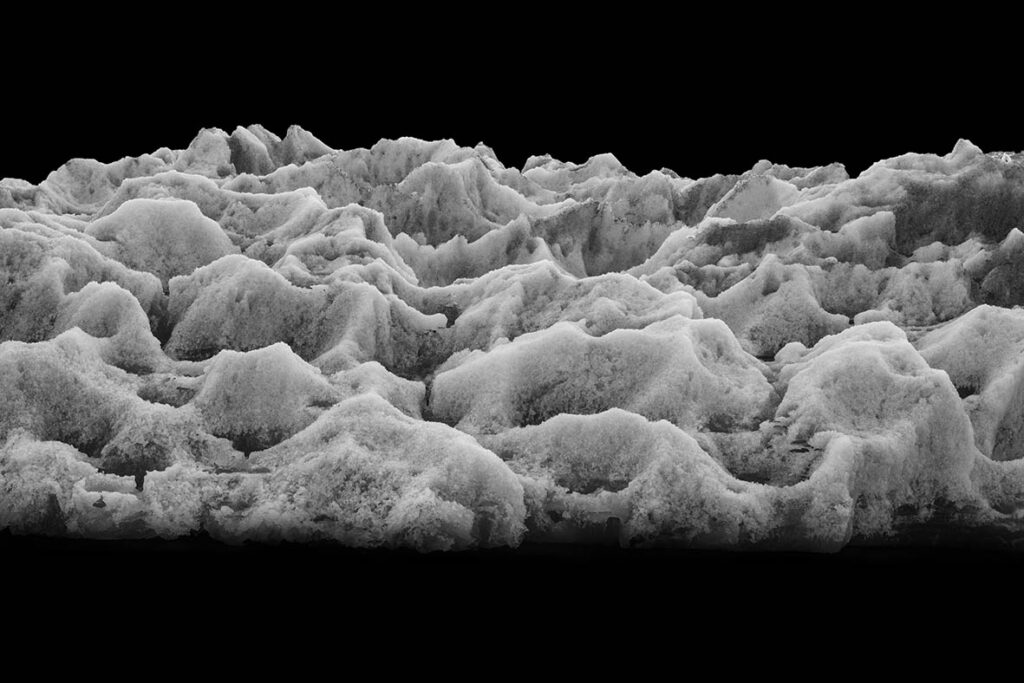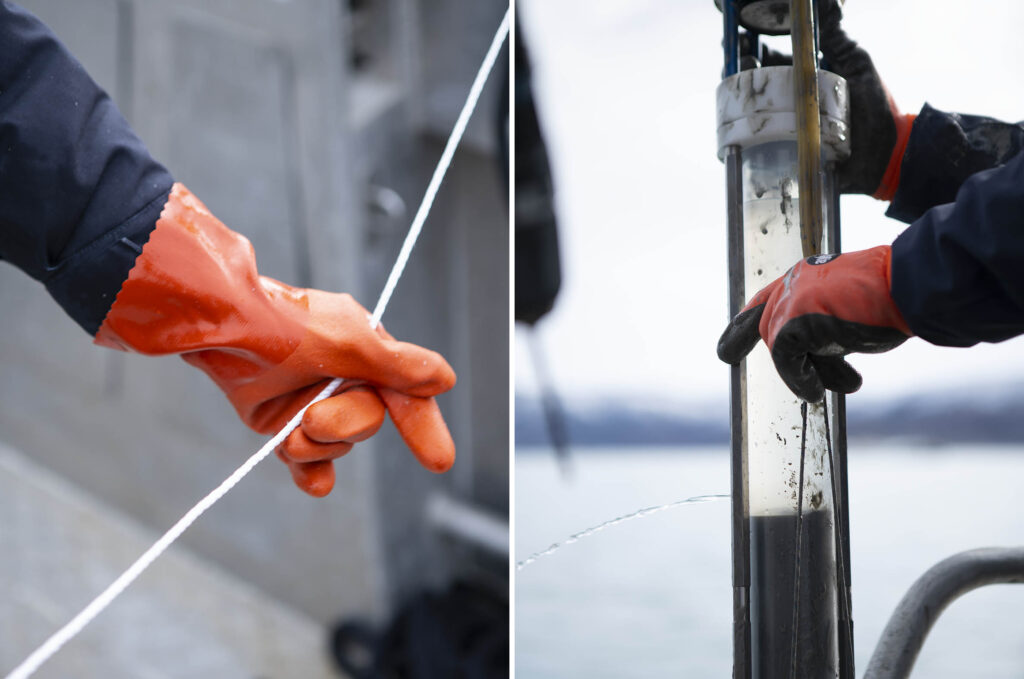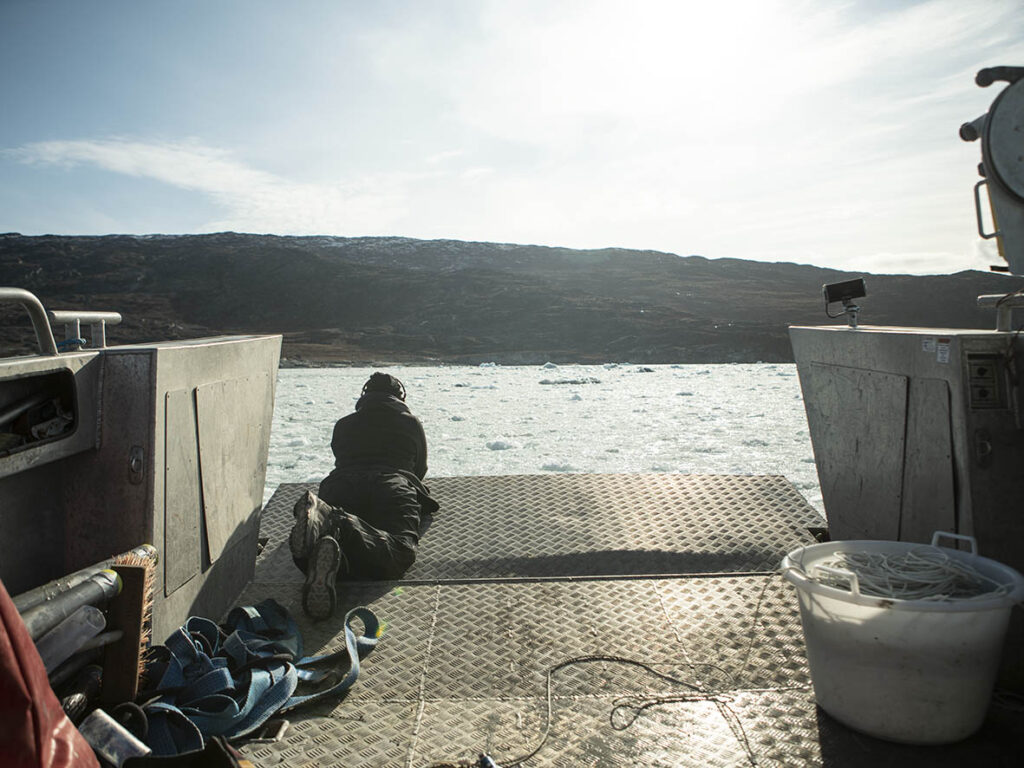As part of their PolARTS project, the author Gianna Molinari and the artist and photographer Christoph Oeschger accompanied the early-career researcher Fien de Doncker on her field trip to West Greenland. Sediment cores, seabed topographies, stories, sounds and pictures were collected.

Fien De Doncker:
The world I experienced around Ilulissat seemed to contain a surprising amount of orange. Perhaps not as much as the striking number of containers that populate Ilulissat, but enough to attract my attention.
Let’s start with the harbour, a busy place where small fishing boats flow in and out and slimy barges with cranes are moved back and forth over the heads of people, houses and boats. From this harbour we – the artists Gianna and Christoph, and co-responsible post-doc Ian – usually sailed by boat to the Eqi Glacier to collect sediments and images from the seabed. It is at this central spot that I first noticed the colour orange: almost all fishermen wear large boots with orange toe tips, green quarters and an orange upper rim. In the boots their blue trouser legs disappear from the dungarees which, next to the boots, seem to be the fishermen’s unofficial costume.
Since I am not a fisherman, I did not wear boots with orange toe tips. Actually, none of my nine layers of clothes were orange, except my waterproof work gloves. They can be found here on every boat and tried in vain to keep my hands warm while coring from the boat. The coring instrument was not orange either, but blue. However, the wide surroundings of Eqi are so blue (the sea and the crumbling glacier ice floating around the boat) and white (the fresh ice) that orange stands out even more in these surroundings. In the plastic tube that is pounded into the sea floor with weights, to be picked up full of sediment, one day, a striking red-orange sea snail was brought up.
The blue coats that Ian and I wore, the hoods pulled over our eyebrows and the collars clamped around our lips to protect us from the rough sea winds, were covered more and more in grey mud of the sediments that we brought up from the seafloor to the surface. The difference between our mud-coated jackets and the metal boat became smaller and smaller. Blending completely into the surroundings must be the biggest advantage of collecting data ourselves, compared to simply receiving them. The first creates a link between the data collector and the data itself. Tubes full of mud suddenly become valuable, just like pieces of paper on which black lines mark outlines of the seabed. Days with a lot of cores – big catch – and little sea ice thus become ‘good days’ and the cake at home tastes all the better.
If the sea is blue, the land looks orange. Behind the colourful houses of the village starts a rough bush that changed from green to deep orange during our time here. Not only the plants are orange, but also the rocks on which dozens of sled dogs are tied. It smells strongly of dead animals and fish.
In the boat, the tapping of the sub-bottom profiler sounds, the instrument with which we study the seabed and the thickness of the sediments that lay there. It’s the heartbeat of an object that seems to have a will of its own and freaks out when it gets too close to sea ice. When, at the end of a boat-day, all the cores of the day have been completed and the sub-bottom profiler is allowed to rest, the colour orange reappears. The long sunset is reflected in the sea, which in turn is broken by the icebergs and pieces of sea ice that float around like pieces of paper in a pond. The sunset continues as we step off the boat and it stretches over our return to the guesthouse until late at night when we sit together around a table dotted coffee mugs and maps to discuss the next day’s plans. After the rising of the moon, an orange sickle hovering above the lights of the village, we are lucky enough to be spectators of the dancing northern lights on the last two evenings of our stay. The bright green colours make me doubt, perhaps this world is rather green.
I had the privilege to work with Christoph and Gianna in this orange (or green) accentuated world, who showed me the world in a different way. Christoph is very good at finding practical solutions and had the great idea of building a wooden arm to carry the subbottom profiler. By following the direction of his lens I noticed the many shades of blue and variations in the shape of icebergs all the more. Gianna, the whale spotter on duty, helped me think about the bigger picture of this expedition with her original questions. Ian, a post-doc at UNIL, who also studies glacial erosion, helped guide the expedition to good ends thanks to his vast experience in fieldwork. So it is not only with dozens of sediment drillings and a memory card full of seabed data, but also with many new lessons that I return to Lausanne. This was the first fieldtrip of several days I did, and then right away in the far North. I felt very insecure, but thanks to Christoph, Gianna and Ian we collected all the data we needed and soon I will be able to analyse these to discover how and why glacial erosion rates varied.

Gianna Molinari:
Wir sind auf der grössten Insel der Welt. Die Insel erhebt sich, wächst jährlich mehrere Millimeter, während das Eis hier so schnell wie nirgendwo sonst schmilzt.
Wir sind auf der Insel, die Trump sich unter den Nagel reissen wollte und auf die schon viele andere Finger zeigen.
Wir sind auf der Insel, die zu einem grossen Teil von Eis bedeckt und von Eisbergen umspült ist.
Heute tauchen Eisberge auf, die gestern noch nicht da waren.
Sie können sich auf den Rücken drehen, unvorhergesehen, und Wellen schlagen.
Man kommt hier nicht an ihnen vorbei.
Mick schon.
Mick fährt das Aluminiumboot, das uns jeden Tag in die Eqi Bay bringt, zwischen Eisbergen hindurch und durch das Meereis, das sich jetzt Mitte September bereits leicht zu bilden beginnt. Er fahre nicht, er segle, sagt Mick. Die Wissenschaftler*innen Fien De Doncker und Ian Delaney lassen eine neue Plastiktube mit der Seilwinde nach unten, die Winde quietscht, rasselt, 40, 60, 90, 120, 160, 240, 310 Meter in die Tiefe, vorbei an den verborgenen Unterseiten der Eisberge, vorbei an einem Grönlandwal, bis tief hinab, bis ganz nach unten zu den Heilbutten.
Plastiktube an Meeresgrund
Orangene Gummihandschuhe an Kunststoffseil
Die Wissenschaftler*innen freuen sich über die Farbvariationen und die Schichtungen in ihrem Sedimentkern und Christoph Oeschger hält Mikrophone über die Reling und fährt mit der Kamera an der Unterwasserkante des Eises entlang.
Linse an Eis
Finger an Auslöser
Rohrschneider an Rohr
Schweizer Sackmesser an Moosgummi
Eis an Aluminium
Hände in Taschen
Hände an Thermoflaschen
Schlamm an Kleidern
Augen an Seilwinde
Augen an Eisbergen
Mal hoch wie Häuser, mal fast schon weggeschmolzen, mal geschichtet, mal abgerundet, mal brüchig, mal glatt, durchscheinend oder weiss und blau und grau und braun in allen Schattierungen.
Ich frage Mick, ob es auf Grönländisch Redensarten gibt, die mit Eis zu tun hätten, so etwas wie: Du bist kalt wie ein Eisberg oder mein Herz schmilzt wie Eis; das nur als Beispiele.
Mick sagt, dass nur alte Menschen solche Dinge sagten, er selber nicht, er habe vergessen.
Er sei ja auch nicht alt, sage ich.
Was er meine, dass dort unten liege?, frage ich Mick.
Er wisse, was dort unten liege, Heilbutte. Sein grösster Heilbutt sei ein Meter achtundzwanzig Zentimeter gross gewesen.
Was die beiden Wissenschaftler*innen denken, dass in den Sedimentproben drin sein wird, Gold?, frage ich.
Vielleicht Gold, sagen sie.
Unser Fang des Tages: Zehn Sedimentkerne gefüllt mit circa 200 Kilogramm Meeresboden sowie 27 Kilometer Meeresbodenvermessung auf Thermopapier gezeichnet.
Christoph mit Bildern und auch ich mit Bildern und mit Fragen:
Wie die Unterseite der Eisberge beschreiben?
Wie vom Meeresboden erzählen?
Wie mehr über das erfahren, was verborgen liegt?
Wird die Welt kleiner oder grösser?
Was war davor?
Die Wissenschaftler*innen sind so erschöpft vom Tag, der Arbeit, der Kälte, dass sie auf der Rückfahrt immer wieder einnicken, während ich aus dem Kabinenfenster schaue und das tue, was ich von allen auf dem Boot am besten kann: Wildtierspotting.
Da bläst er, rufe ich und ein riesengrosser Wal zeigt seinen riesengrossen Rücken.
Während Mick zurück in den Hafen segelt, läuft der Soundtrack von The Life Aquatic mit Steve Zissou.
Was unter anderem nicht herauszufinden war: Wie schnell bewegen sich Eisberge in der Nacht und wer schaut unter Wasser zu, wenn die Gletscher kalben.

Fien de Doncker is a PhD student at the University of Lausanne. Her field note relates to her field trip to Greenland in September 2020 funded by a Polar Access Fund grant. Gianna Molinari is a novelist and Christoph Oeschger an artist, both supported through PolARTS, who accompanied Fien on her field trip. Pictures: Christoph Oeschger
© All rights reserved, de Doncker, Molinari, Oeschger 2025